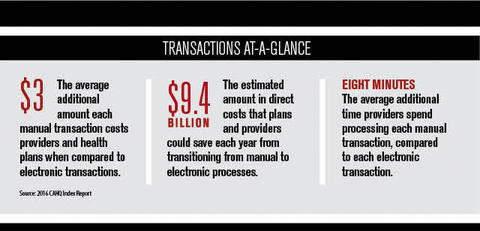Administrative costs make up about 15% of all healthcare expenditures--well over $300 billion annually, according to the 2016 index report from the California Association for Healthcare Quality. Outdated, manual processes and rejected claims eat up a large portion of this cost.
The key to reducing administrative costs lies in refining these processes and changing with the times, according to industry leaders. Here are five strategies to consider implementing at your organization.
Digitize processes, verify benefits
One of the biggest drains on healthcare is the administrative cost associated with the revenue cycle. Minor mistakes associated with benefit verification, denial management, and claims resubmission can become very costly.
Streamline physician work flow
Happy workers make successful workplaces, and it goes without saying that recent changes in healthcare have increased the administrative burden on clinicians. Helping them streamline their work flow will increase efficiencies and savings, says Jay Anders, MD, chief medical officer at Medicomp Systems, a medical device manufacturer and developer.
Use digital engagement solutions
Jean Drouin, MD, MBA, CEO, and cofounder of the healthcare analytics firm Clarify Health Solutions, says payers and providers are facing the question: How do we create more effective and efficient care models that deliver the same or better outcomes at lower costs?
"The private physician will now make more if he or she steps the patient down as fast as possible," Drouin says. "Longer stays means higher costs, and if costs are higher than allowed in that period, the physician will be penalized. In order to change the behavior, we need to be providing far more patient and physician level data so clinicians are able to make better choices and reward them for making those choices."
Open communication to let data flow
Mark Martin, director of payer and vendor services at Availity, says interactions between plans and providers have gone from bad to worse during the transition to value-based reimbursements. "The communication between health plans and providers is archaic, and for the most part that just leads to just bad communication back and forth," he says.
Outsource with purpose
Anand Natampalli, vice president of global business development for the business process management firm HGS, says outsourcing allows certain processes to be completed by outside experts--leaving health systems to focus on patient care.
[...]
Source: Managed Healthcare Executive (View full article)
Posted by Dan Corcoran on November 28, 2017 06:54 AM



Post a comment